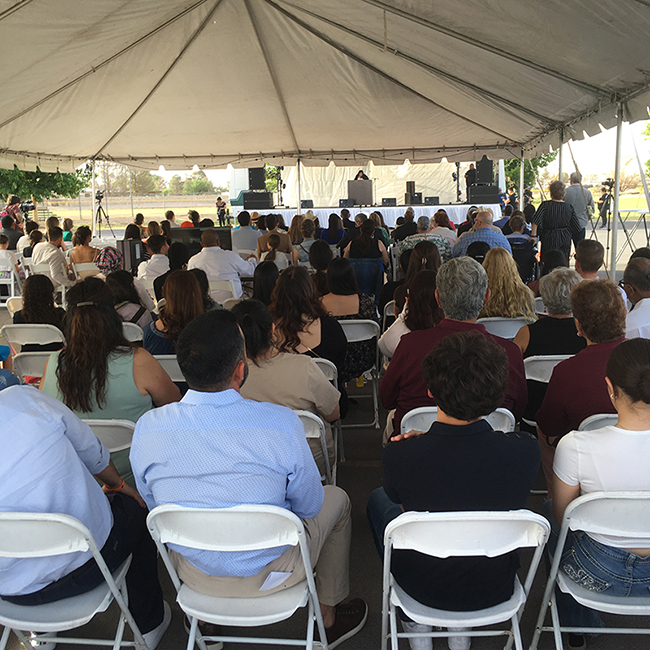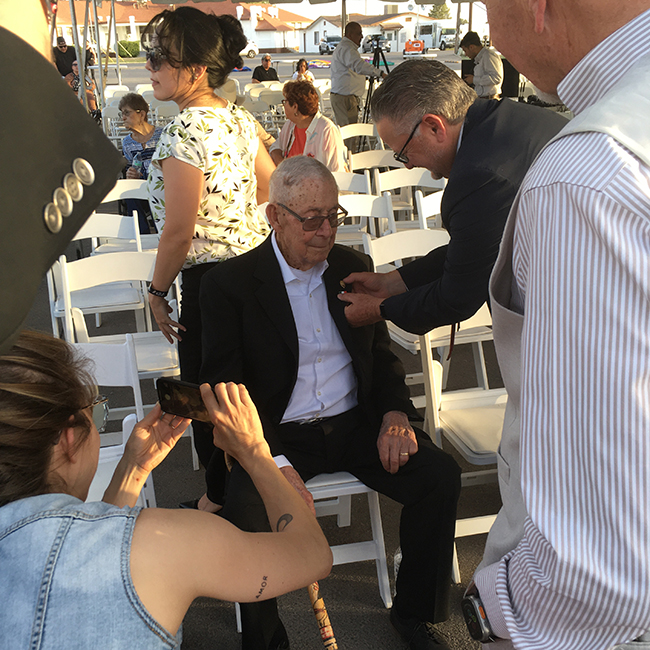By Kent Paterson
For the first time in 60 years, Sebastián Corral touched the earth of Rio Vista Farm in Socorro, Texas. Now 91 years old, Corral was among the braceros, Mexican contract guestworkers, who were first enlisted in 1942 to alleviate the extreme labor shortage hovering over U.S. farms and railroads when men were swept into World War Two and women recruited for factory work. Food and transportation disruptions loomed. Mexico, however came to the rescue.
“Braceros save the crops! There was this feeling of euphoria that Mexican workers were going to save the day,” said Dr. María Herrera-Sobek, then director of Chicano Studies at the University of California Irvine, who was interviewed for a 1995 radio series about Bracero Program history produced by this reporter.
The Bracero Program was extended after the war, with Rio Vista Farm emerging in 1951 as one of the main processing and recruiting centers along the U.S.-Mexico border until the labor system was canceled in 1964.
Although the braceros were initially greeted with open arms and even gala events, the dark side of the program was readily evident to men like Corral, who were subjected to a delousing regimen with toxic pesticide and subjected to other physical and psychological humiliations at Rio Vista.
“They bathed us as if we were cattle in stables,” Corral told a rapt audience gathered in Socorro, Texas, on May 11 to inaugurate the first national historic monument dedicated to the Bracero Program at the old Rio Vista Farm.
Originally from the state of Chihuahua, Corral first passed through Rio Vista in 1953. Over the years, he worked in New Mexico, Texas, Colorado and Wyoming-wherever farmers and ranchers called for helping hands. Earning between $10-$15 per day, he labored in cotton, sugar beet, lettuce and cabbage crops.
Corral recounted an incident that’s stuck with him throughout the decades. One Saturday, he traveled down the road from Doña Ana, New Mexico to neighboring El Paso, where he entered a restaurant only to be informed by a waiter that he wouldn’t be given service.
“Why can’t you serve me?”
“Because you’re Mexican.”
Angered by the encounter, Corral strode off to find a diner that would serve a hungry working man. “But that happened to me at the other restaurant. I hope that other restaurant doesn’t exist anymore,” he concluded, drawing a round of applause from the crowd.
Like countless other braceros, Corral returned to the U.S. as an undocumented worker after the Bracero Program was terminated. He later gained permanent legal residence and, most recently, his U.S. citizenship. Settling in New Mexico, he was employed for 30 years in a dairy.
The old bracero’s daughters, Gloria Nuñez and Blanca Ortega, were among the many on hand a windy spring day at Rio Vista Farm to hear their father’s remembrances.
For the New Mexico residents, it was a bittersweet ceremony that recalled long periods of family separation while Dad was off working in El Norte, times of struggle that tested the human spirit yet also heralded eventual triumphs to celebrate.
“I feel sad about what he went through, the experiences and discriminations he had. How was it possible that he was discriminated against just because he was Mexican and came from another country? The (braceros) were treated in an inhuman way,” Nuñez said.
“But I am now really proud of my father for all his achievements, and I heard him say that he would do it all over again if it meant having his family together.”
“I agree,” Ortega added. “We’ve heard these stories different times but they still move us as if they were the first time he told them to us. But it’s like he said, he would do it all over again for us.”
Nuñez said she was surprised Rio Vista Farm still existed, adding it was the first time she and her sister had seen the legendary place long ago etched into their family history.
The official inaugural of the bracero landmark at Rio Vista Farm featured music by Frontera Bugalú, folkloric dancers, vendors, and a host of speakers, including El Paso County Commissioner Iliana Holguin, County Judge Ricardo Samaniego, and Texas State Representative Mary González, among others.
“I think we have finally come to the conclusion that our stories and who we are as a community has to come to fruition not only for us, but for the entire country if not the entire world,” he said. “We’re in the front row of immigration and get to see the suffering and everything that happens. And when you hear Sebastián talk about what’s happening, don’t forget that it’s still happening. It just takes a different direction.”
Samaniego continued: Now it’s human trafficking, the abuse that individuals go through as they’re coming here, and every contribution that our immigrants have made in our country and who we are because of them. We need to honor them. And so when we close the doors to immigrants, you will close the door to Sebastián, for example. Wouldn’t that have been a sad story that we had closed the door to a gentleman who has so much commitment. Look at the faith that he has…”
For the County Judge, the new bracero landmark is a “call to action.”
Mauricio Ibarra Ponce de León, Counsel General of the Mexican Consulate in nearby El Paso, connected the Bracero Program to historical, social and economic relationships between Mexico and the United States, telling his listeners that “millions of Mexican Americans” can trace their roots to a relative who was in the Bracero Program. In dollar terms, Mexican workers contribute $265 plus billion dollars to the U.S. economy, the career diplomat said.
“And again, having Rio Vista Farm recognized as a national historic landmark will be a continuous reminder of those Mexicans that came to work during complicated moments, were successful and left a legacy in the U.S. such as Mr. Sebastián Corral.”
More recently, Mexican workers once again stepped up to the plate in a time of disaster and danger, Ponce de León reminded the audience, pointing out that 7 of 10 agricultural workers in the U.S. are of Mexican origin.
“And that is the reason why during the pandemic that Mexican workers were considered essential personnel,” he said.
Remember COVID-19 and essential workers? The Mexican-born meatpackers and farmworkers who succumbed to the disease while working away to provide food for people cooped up in their homes?
As the ceremony wound down, El Paso’s Mexican Consul pinned a recognition from his government on Sebastian Corral’s coat.
Visibly moved by the day’s events, Don Sebastián sat down as relatives and well wishers buzzed about him. It was an emotional scene, replete with old memories-some of them not very pleasant. But that Saturday in Socorro also proved a time for taking stock of the good that life offers.
“I feel the greatest of great, in spite of old times being old times,” Corral reflected. “The situation here is different now: there are beautiful things. To me, having my family together here is the best it can get.”
Situated in El Paso’s Lower Valley, the new Rio Vista Bracero Reception Center National Historic Landmark was born from decades of hard work by academic researchers, ex-braceros, government agencies, elected officials, and community members. A partial list includes Dr. Yolanda Leyva and UTEP staff, the National Trust for Historic Preservation, the National Park Service, the Mellon Foundation, and the City of Socorro.
Two plaques, one in Spanish and one in English, now mark the place where thousands of braceros stopped on their way to U.S. farms and ranches.
A national organization, Latinos in Heritage Conservation is another instrumental force in making the landmark a reality.
Interviewed at the May 11 ceremony, Latinos in Heritage Conservation Executive Director Sehila Mota Casper described years of painstaking research that got into full gear when she was once employed by the National Trust for Historic Preservation, a position which led her to the under recognized Rio Vista Farm site as the prime place for a landmark and future museum, which is slated to begin construction next August.
Along the way Mota Casper experienced a familial revelation when she discovered that one of her grandfathers had been a bracero too.
“I knew that my relatives were working over here, but I never knew that (grandfather) was a bracero,” Mota Capser said. “We can encounter such things among our relatives, and many things that really aren’t talked about because they are matters of immigration, or perhaps things that hurt. The people made many sacrifices.”
Prior to the Bracero Program, Rio Vista Farm served as an El Paso County poor farm and was the site of Roosevelt-era Works Progress Administration and Civilian Conservation Corps projects.
Gradually, Rio Vista Farm’s historical value was recognized by a growing number of people and organizations. In 1997, the old farm was listed in the National Register of Historic Places.
In 2015 Rio Vista Farm was included on the State of Texas’ Most Endangered Places List, designated as a National Treasure by the National Trust for Historic Preservation in 2016, and together with UTEP as a site for the Bracero History Summit in commemoration of the 75th anniversary of the Bracero Program in 2017.
Finally, in December 2023, the property was named a national historic landmark by Interior Secretary Deb Haaland.
Nowadays, some of Rio Vista Farm’s historic buildings function as administrative offices of the City of Socorro and house the Rio Vista Community Center. But much, much more is still expected to come in addition to the planned bracero museum.
Also present for the landmark ceremony, Victor Reta, City of Socorro spokesman, said the municipal government is spearheading a major rehabilitation of Rio Vista Farm that will also feature Socorro’s first public library, senior citizens programs, and an array of economic development, health care and educational services and facilities.
“There is something for all. It could be a festival, classes or resources. It’s going to be a place for everyone,” Reta said. And, of course, the bracero era remains an important chapter in the ongoing story of Socorro.
“The history of braceros is very well known or not, depending if people lived and grew up here,” Reta said. “But in the city, in the community, we are very proud of them. This program has made our community bigger. We can connect our grandfathers and great-grandfathers and know how our individual families grew.”
Note: Persons interested in contributing photos, stories, documents and other relevant materials for the future bracero museum at Rio Vista Farm can email hello@costx.us or call 915-860-8615.
Feature photo: Sehila Mota Capser of Latinos in Heritage Conservation at Rio Vista Farm, 11 May 2024. Her grandfather was a bracero.
Photos by Kent Paterson.






Finally, a piece of decent news. Sadly, it took forever for him to be recognized.
Rio Vista Farm and the bracero program is an important part of El Paso history that not enough of us know about or truly understand, and Kent Paterson is the perfect storyteller.